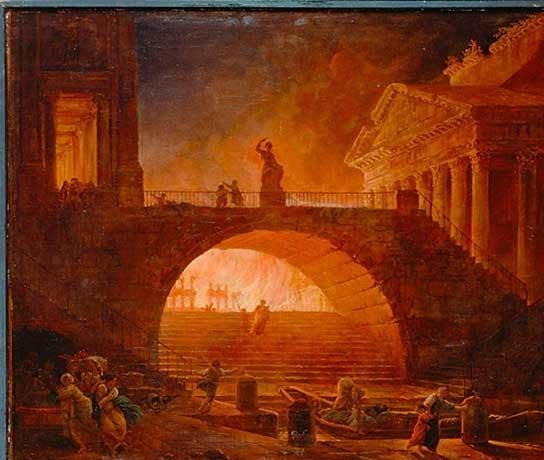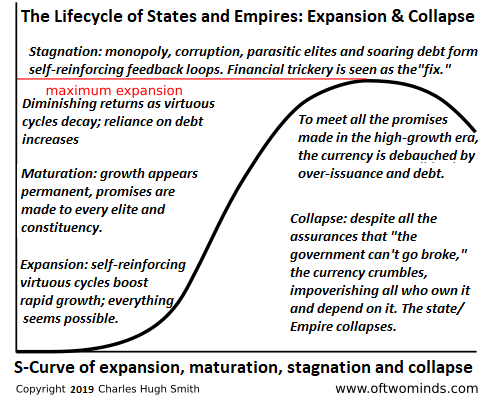The higher up the wealth-power pyramid the observer is, the more prone they are to a magical-thinking belief that the empire is forever, even as it is crumbling around them. How great nations and empires arise, mature, decay and collapse has long been of interest for a self-evident reason: if we can discern a template or process, we can predict when the great nations and empires of today will slide into the dustbin of history. One of the justly famous attempts to lay out the stages of expansion, zenith, decline and collapse is Sir John Glubb’s 1978 The Fate of Empires. Succinct and deeply informed, Glubb’s essay lists these stages: The Age of Pioneers (outburst or Boost Phase) The Age of Conquests The Age of Commerce The Age of Affluence The Age of Intellect
Topics:
Charles Hugh Smith considers the following as important: 5.) Charles Hugh Smith, 5) Global Macro, Featured, newsletter
This could be interesting, too:
Nachrichten Ticker - www.finanzen.ch writes Die Performance der Kryptowährungen in KW 9: Das hat sich bei Bitcoin, Ether & Co. getan
Nachrichten Ticker - www.finanzen.ch writes Wer verbirgt sich hinter der Ethereum-Technologie?
Martin Hartmann writes Eine Analyse nach den Lehren von Milton Friedman
Marc Chandler writes March 2025 Monthly
|
The higher up the wealth-power pyramid the observer is, the more prone they are to a magical-thinking belief that the empire is forever, even as it is crumbling around them. How great nations and empires arise, mature, decay and collapse has long been of interest for a self-evident reason: if we can discern a template or process, we can predict when the great nations and empires of today will slide into the dustbin of history. One of the justly famous attempts to lay out the stages of expansion, zenith, decline and collapse is Sir John Glubb’s 1978 The Fate of Empires. Succinct and deeply informed, Glubb’s essay lists these stages: The Age of Pioneers (outburst or Boost Phase) The Age of Conquests The Age of Commerce The Age of Affluence The Age of Intellect The Age of Decadence The slippery slope to collapse–decadence–is characterized by greed, corruption, irreconcilable internal political rifts, moral decay, frivolity, materialism–hmm, sound familiar? All of this fits the S-Curve model which I’ve described here many times, for example: |
The Lifecycle of States and Empires: Expansion & Collapse |
| But what triggers the collapse of a weakening but still functioning empire? For that, I propose a taxonomy of collapse. A taxonomy is a system of classification that groups organisms or types that share characteristics and origins.
What taxonomy of collapse does history suggest? I would start with: 1. Bolt from the blue: a fast-moving, unexpected crisis that overwhelms the usual defenses and responses of the empire. An invasion by previously unknown forces with superior technology and/or organization fits the bill: the Mongols in Eurasia, the Spanish in the New World, etc. Extremely contagious and previously unknown infectious diseases like plague and smallpox are also bolts from the blue, devastating populations with no immunity. It is estimated that 80% or more of the population of North America died from exposure to smallpox and other European diseases, in many cases long before the victims had ever seen a European, as the diseases spread much faster than the invaders themselves. A drought that never ends is another unexpected catastrophe that quickly depletes food stores. These bolts from the blue can strike at the same time: one reason why the small-in-number Spanish forces conquered vast empires in the New World was the empires had already been fatally weakened by diseases introduced by Columbus decades earlier. |
 . |
2. Irreplaceable declines in essential resources. Food tops the list, as a decline in calories leads to weakened immune systems and heightened odds of pandemics spreading and a subsequent drop in the number of workers needed to support the empire’s vast infrastructure.
The book The Fate of Rome: Climate, Disease, and the End of an Empire makes a compelling case that the Western Roman Empire centered around the Mediterranean suffered from a slow environmental transition from an unusually wet era that enabled grain to be grown in previously marginal areas to a drier era that no longer supported the immense grain harvests needed to feed the empire.
Other forms of depletion can also sap the empire of essentials: forests are cut down, silver mines are tapped out, nearby sources of slaves (labor) are no longer available, and so on.
The imperial machinery that is accustomed to there’s always more somewhere refuses to trim its expenses, elites refuse to lessen their skim, and since the fat of elite excess is retained, eventually the muscle of military power and trade decay, leaving a hollowed out empire on the edge of a precipice awaiting one final kick into the abyss.
3. Reversal of fortune. Military misadventures top the list, as invasions of nearby competing powers are in effect last-ditch gambles to acquire desperately needed wealth and resources to prop up the status quo. When the imperial army is defeated and destroyed, there are no longer sufficient resources and recruits to rebuild the army.
4. Internal civil conflict: civil wars and political conflicts that break out into society and the economy end up consuming the last of the empire’s seed corn, just like an invasion of a bordering empire that fails. Once the conflict is resolved, there are no longer enough resources left to support the imperial infrastructure.
Like Nature, History offers a near-infinite variety, but just as Nature fits into taxonomies of organisms, history can be shuffled into its own taxonomy, however messy and imperfect it might be.
These triggers of collapse can overlap, of course, accelerating the final decline. All complex hierarchical systems are intrinsically fragile and prone to disruption; we don’t see the fragility or vulnerabilities until the decline has reached the terminal phase. The higher up the wealth-power pyramid the observer is, the more prone they are to a magical-thinking belief that the empire is forever, even as it is crumbling around them.
Tags: Featured,newsletter

